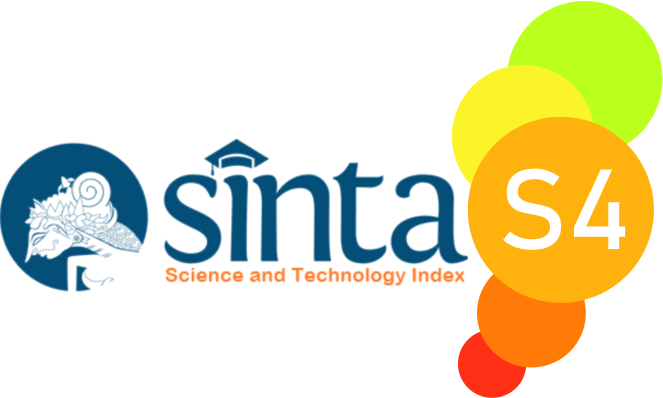Challenges Encountered by an Active Bilingual Child in Productive Skills
Abstract
The purpose of this study was to describe the bilingual child's ability and challenges in speaking and writing in two languages: Bahasa Indonesia and English. This research was designed by using a case study. The subject of this research was an 11-year-old, who communicated in both Bahasa Indonesia and English. Data were collected through observation, interview, video recording of the child’s speaking English and Bahasa Indonesia, and document analysis. The result showed that the subject was an active bilingual child because he actively spoke Bahasa Indonesia as his mother tongue and English as his second language. In English speaking, he had constraints in pronouncing /wɑː.zənt/, /bɑːt/. In speaking Bahasa Indonesia, he missed spealing some words, such as Hari, Dermaga, Bermain. In, writing English, he had difficult in writing words. He dominantly had challenge in writing the Indonesian Language, especially in developing content, vocabulary used, and in grammar used.
References
Anggung, S. D., Basri, M., & Salija, K. (2022). Teachers ’ Bilingual Use in an Indonesia Primary Education. Jornal of Art, Humanity and Social Studies, 2(2), 16–26.
Azka, M. Y. A., Ali, M., & Narimo, S. (2022). Implementasi Kurikulum Bilingual Dalam Meningkatkan Kualitas Bahasa Inggris di SD Bilingual . Jurnal Sinektik, 5(1), 8–14. https://doi.org/10.33061/js.v5i1.6812
Baker, C., & Wright, W. E. (2017). Foundations of Bilingual Education and Bilingualism (6th ed.). Multilingual Matters
Baxter, P., & Jack, S. (2008). Qualitative Case Study Methodology: Study Design and Implementation for Novice Researchers. The Qualitative Report, 13(4), 544-559. https://doi.org/10.46743/2160-3715/ 2008.1573
Bogdan, R.,& Biklen, S. (1992). Qualitative Research for Education.United States of America
Cañado, M. L. P. (2020). Implementing Bilingual Education in Monolingual Contexts : Lessons Learned and Ways Forward. The Language Learning Journal, 48(1), 1–4. https://doi.org/10.1080/09571736.2020.1695622
Dourou, C., & Dosi, I. (2021). One Word, Two Definitions: A Comparison of Word Definitional Skills between Monolingual and Bilingual Students. Journal of Education and Practice, 12(8), 1–12. https://doi.org/10.7176/JEP/12-8-01
Ekorini, P. Z. (2021). An Analysis on Students’ Mistakes in Writing a Recount Text (A Case Study on Eighth-Grade Students of Mts Al-Amin Ngetos , Nganjuk). Epigram, 18(1), 49–58.
Etikan, I., Musa, S. A., & Alkassim, R. S. (2016). Comparison of Convenience Sampling and Purposive Sampling. American Journal of Theoretical and Applied Statistics, 5(1), 1–4. https://doi.org/10.11648/j.ajtas.20160501.11
Halitoğlu, V. (2021). Determination of the Writing Errors of Bilingual Turkish Students in France (Example of Lyon). Participatory Educational Research, 8(4), 297–320.
Hardiyanti, R. (2017). Analysis on the Difficulties Faced by a Bilingual Child in Reading and Writing. Advances in Language and Literary Studie, 8(4), 43–49.
Jayanti, D., & Sujarwo, A. (2019). Bilingual Education In Indonesia : Between Idealism and the Reality. Journal of Linguistic and English Teaching, 4(1), 12–26.
Khabirova, N. M., & Abrosimova, G. A. (2016). The Phenomenon of Bilingualism on the Current Stage. International Journal of Humanities And Cultural Studies, 2016, 74–80.
Mile, M.,& Huberman, M. (1984). Qualitative Data Analysis. Beverly Hills, CA: Sage
Mulyani. (2017). Identifying the Concept of Bilingualism and Bilinguals Through Seven Baker ’ S Dimensions Of Bilingualism. Englisia, 5(1), 29–40.
Murad, T., Yusra Ghadeer, S., & Assadi, J. (2021). The Effect of Teachers ’ Attitudes Towards Collaborative Instruction on Students ’ Writing and Speaking Skills. Journal of Language Teaching and Research, 12(3), 343–351.
Nzai, V. E., & Boleli, F. K. (2013). Challenges Faced by Bilingual Children from Mixed Parents in Predominantly Monolingual-Monocultural Spanish- Speaking Extended Families. Mextesol Journal, 37(2), 1–9.
Özdemi̇r, H., & Çiftçi, Ö. (2021). The Evaluation of Monolingual and Bilingual Students ’ Writing Skills in Fifth Grade of Secondary School Comparatively. International Journal of Education & Literacy Studies, 9(3), 85–91.
Portole´s-Falomir, L. (2012). Bilingual youth: Spanish in English-Speaking Societies. International Journal of Bilingual Education and Bilingualism, 126–130.
Rahayu, P. (2015). Students’ Speaking Skill through Animation. Jurnal Bahasa Dan Sastra Inggris, 2(1), 25–33.
Rashid, Y., Rashid, A., & Warraich, M. A. (2019). Case Study Method: A Step-by-Step Guide for Business Researchers. International Journal of Qualitative Methods, 18, 1–13. https://doi.org/10.1177/1609406919862424
Sihotang, A. M., Sitanggang, F., Hasugian, N., & Saragih, E. (2021). The Effective Way To Develop Speaking Skills. Journal of Language Teaching and Learning, Linguistics and Literature, 9(1), 1–8. https://doi.org/10.24256/ideas.v9i1.1777
Copyright (c) 2022 Putu Devi Mas Wulandari, Ni Putu Era Marsakawati, Ni Luh Putu Eka Sulistia Dewi, Made Hery Santosa

This work is licensed under a Creative Commons Attribution-ShareAlike 4.0 International License.

Journey: Journal of English Language and Pedagogy by http://ejurnal.budiutomomalang.ac.id/index.php/journey/index is licensed under a Creative Commons Attribution-ShareAlike 4.0 International License.






